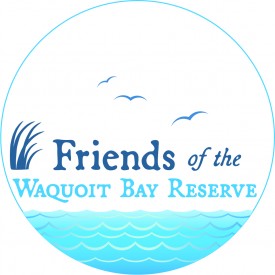MBL Logan Science Journalism Program – water and biota sampling
Project Title: MBL Logan Science Journalism Program – water and biota sampling
Duration: May to June 2025
Funding Source: Marine Biological Laboratory
Lead Investigator / onsite-contact: Jim McClelland
Affiliation: MBL Ecosystems Center
Email: jmcclelland@mbl.edu
Project Description: Journalists participating in MBL’s Logan Science Journalism Program (SJP) will visit the Waquoit Bay system to learn field sampling techniques and collect material (water and biota) for lab analyses. The Logan SJP provides hands-on research experience to journalists seeking to enhance their understanding of the scientific process and improve their science-oriented reporting. The Waquoit Bay system is leveraged to teach/learn about causes and consequences of nutrient loading to estuaries as well as potential solutions to eutrophication.
The impact of excess nutrients on Waquoit Bay estuarine biota
Project Title: The impact of excess nutrients on Waquoit Bay estuarine biota
Duration: May-2023 to December-2023
Funding Source(s): Various educational programs at MBL, including the Logan Science Journalism Program, the NSF-REU Biological Discovery in Woods Hole Program, the University of Chicago Metcalf Summer Internship Program, the Brown-MBL LINK Internship Program, and the Semester in Environmental Science.
Lead Investigators: Mirta Teichberg
Onsite-contact: Kelsey Chenoweth
Affiliation: Marine Biological Laboratory
Email: kchenoweth@mbl.edu
Project Description: Teichberg, with several groups of students, fellows, and faculty from several educational programs at the Marine Biological Laboratory, will be developing projects aimed at understanding the effects of excess nutrient loadings on ground- and estuarine water quality, and their impacts on the food webs of the various Waquoit Bay estuaries. They will define links between nitrogen loads from shifting land use and atmospheric deposition for the region, groundwater nitrogen concentrations, and water quality indicators in selected receiving estuaries. To achieve this goal, they will evaluate how changing climate drivers (increased rainfall, lowered nitrogen concentrations in deposition, and higher temperatures) alter timing and amount of nitrogen discharged from watersheds to receiving estuaries. They will also examine how excessive nitrogen loads alter the composition and structure of estuarine food webs. Waquoit Bay’s range in nitrogen loads will serve as a wider context within which to place data from other local estuaries.
Restoring hydrology using runnels and salt marsh N biogeochemistry
Project Title: Restoring hydrology using runnels and salt marsh N biogeochemistry
Duration: Aug 2022-Jul 2024
Funding Source(s): Margaret A. Davidson Graduate Fellowship, NOAA
Lead Investigator / onsite-contact: Linda Deegan, Jen Bowen, Meagan Tyrrell
Affiliation: Woodwell Climate Research Center; Northeastern University
Email: hsullivan@woodwellclimate.org
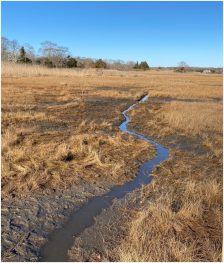 Project Description: Salt marshes are highly dynamic and variable systems providing many ecosystem services such as shoreline stabilization and nutrient filtration. However, because of their location within the tidal frame and proximity to human activity, they are vulnerable to a combination of anthropogenic and climatic disruptions. The objectives of this project are to understand the effects of altered hydrology via sea-level rise on the vulnerability of salt marsh productivity and N removal, and if restoration can enhance the resiliency to future changes. We will implement a relatively new restoration strategy called runnels, which are shallow channels designed to help drain standing water off the marsh surface and encourage vegetation. This project will examine unintended consequences of such restoration strategies on N cycling.
Project Description: Salt marshes are highly dynamic and variable systems providing many ecosystem services such as shoreline stabilization and nutrient filtration. However, because of their location within the tidal frame and proximity to human activity, they are vulnerable to a combination of anthropogenic and climatic disruptions. The objectives of this project are to understand the effects of altered hydrology via sea-level rise on the vulnerability of salt marsh productivity and N removal, and if restoration can enhance the resiliency to future changes. We will implement a relatively new restoration strategy called runnels, which are shallow channels designed to help drain standing water off the marsh surface and encourage vegetation. This project will examine unintended consequences of such restoration strategies on N cycling.
The impact of excess nutrients in Waquoit Bay estuaries
Project Title: The impact of excess nutrients in Waquoit Bay estuaries
Duration: April-2022 to December-2022
Funding Source(s): Various educational programs at MBL, including the Logan Science Journalism Program, the NSFREU Biological Discovery in Woods Hole Program, the University of Chicago Metcalf Summer Internship Program, the Brown-MBL LINK Internship Program, and the Semester in Environmental Science.
Principal Investigator and institutional affiliation
Lead Investigator: Javier Lloret
Affiliation: Marine Biological Laboratory
Project Description:
Dr. Lloret, together with several groups of students, interns, and faculty from several educational programs at the Marine Biological Laboratory, will be developing projects aimed at understanding the effects of excess nutrient loadings on ground- and estuarine water quality, and their impacts on the food webs of the various Waquoit Bay estuaries. They will define links between nitrogen loads from shifting land use and atmospheric deposition for the region, groundwater nitrogen concentrations, and water quality indicators in selected receiving estuaries. To achieve this goal, they will evaluate how changing climate drivers (increased rainfall, lowered nitrogen concentrations in deposition, and higher temperatures) alter timing and amount of nitrogen discharged from watersheds to receiving estuaries. They will also examine how excessive nitrogen loads alter the composition and structure of estuarine food webs. Waquoit Bay’s range in nitrogen loads will serve as a wider context within which to place data from other local estuaries.
Mercury loading in estuarine food webs in relation to nitrogen loading
Title: Mercury loading in estuarine food webs in relation to nitrogen loading
Duration: July 2011-October 2017
Funding Source: WHOI Sea Grant
Lead Investigator: John Logan
Affiliation: Massachusetts Division of Marine Fisheries
Contact: john.logan@mass.gov
Description: This project seeks to understand the relationship between eutrophication and mercury bioaccumulation in estuarine
food webs. Recent work has shown elevated mercury concentrations in groundwater entering estuaries in Cape Cod,
Massachusetts, possibly due to mobilization mediated by eutrophication. To assess the extent of mercury transfer from
groundwater to aquatic food webs and test the proposed relationship with eutrophication, we are sampling
representative estuarine biota from Waquoit Bay and three neighboring estuaries with different nitrogen loads. We plan
to relate mercury concentrations to nitrogen loading as well as trophic interactions using stable isotope tracers.
Forecasting Rates of Sediment Nutrient and Metal fluxes under Coastal Acidification
Title: Forecasting rates of sediment nutrient and metal fluxes under coastal acidification for improved estuarine water quality
Year: 2020-2022
Principal Investigator/contact information:
Claudia I. Mazur (she/her)
Ph.D. Candidate, Fulweiler Lab
NOAA Margaret A. Davidson Fellow
Earth & Environment, Boston University
Email: cmazur@bu.edu
Lab Website: fulweilerlab.com
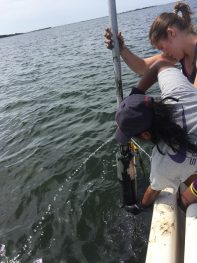 Abstract: Coastal acidification refers to the reduction in pH of coastal waters. Unlike the open ocean, coastal acidification is driven by excess nitrogen (N). This N fuels primary productivity and the subsequent decomposition of this organic matter lowers estuarine pH. In fact, estuaries experience pH shifts of ≥ 0.5 daily. Thus, estuaries are natural laboratories in which to study how acidification alters fundamental ecosystem processes such as nutrient filtration and cycling. The purpose of this research is to determine the impact of coastal acidification on sediment N, phosphorus (P), and iron (Fe) cycling. To address this issue, I will experimentally manipulate pH in the overlying water column of sediment cores collected from Waquoit Bay, MA. Using continuous flow through incubations, I will quantify rates of sediment denitrification (microbial removal of N to di-nitrogen gas), N, P and Fe fluxes. I will use these findings and data from the WBNERR System-Wide Monitoring Program to develop a model that will predict the impact of low pH conditions on these fluxes and future water quality in Waquoit Bay. This study will be a crucial link to understanding how coastal acidification alters total ecosystem productivity, biogeochemical cycling and water quality.
Abstract: Coastal acidification refers to the reduction in pH of coastal waters. Unlike the open ocean, coastal acidification is driven by excess nitrogen (N). This N fuels primary productivity and the subsequent decomposition of this organic matter lowers estuarine pH. In fact, estuaries experience pH shifts of ≥ 0.5 daily. Thus, estuaries are natural laboratories in which to study how acidification alters fundamental ecosystem processes such as nutrient filtration and cycling. The purpose of this research is to determine the impact of coastal acidification on sediment N, phosphorus (P), and iron (Fe) cycling. To address this issue, I will experimentally manipulate pH in the overlying water column of sediment cores collected from Waquoit Bay, MA. Using continuous flow through incubations, I will quantify rates of sediment denitrification (microbial removal of N to di-nitrogen gas), N, P and Fe fluxes. I will use these findings and data from the WBNERR System-Wide Monitoring Program to develop a model that will predict the impact of low pH conditions on these fluxes and future water quality in Waquoit Bay. This study will be a crucial link to understanding how coastal acidification alters total ecosystem productivity, biogeochemical cycling and water quality.
Water quality monitoring and modelling in Waquoit Bay estuaries
Project Title: Water quality monitoring and modelling in Waquoit Bay estuaries.
Date: 6/2019-11/2019
Principal Investigator(s): Ivan Valiela, Javier Lloret
Affiliations: Marine Biological Laboratory- The Ecosystems Center
Summary: The Valiela Lab, in addition to visiting students from the University of Chicago, Brown University, and the Semester in Environmental Science Program, will be developing projects aimed at understanding the relationship between watershed nitrogen loading and estuarine water quality in the Waquoit Bay estuaries. Building off of a series of recent project work undertaken in Waquoit Bay, we will continue to define links between N loads from shifting land use and atmospheric deposition for the region and water quality indicators in selected receiving estuaries. To achieve this goal, we will evaluate how changing climate drivers (increased rainfall, lowered nitrogen concentrations in deposition, and higher temperatures) alter timing and amount of N discharged from watersheds to receiving estuaries. Waquoit Bay’s range in N loads will serve as a wider context within which to place data from other local estuaries.
In addition, Javier will oversee the continuation of research begun during the SES 2018 semester on microplastics contamination in Waquoit Bay with a new cohort of students in 2019.
Coupling sediment Fe(II) oxidation with denitrification and DNRA
Project Title: Coupling sediment Fe(II) oxidation with denitrification and DNRA
Date: 2019-2020
Principal Investigator(s): Claudia Mazur, Robinson Fulweiler
Affiliations: Boston University
Summary: Nitrogen is an essential nutrient for primary productivity in coastal systems, yet excess nitrogen loading from human activities such as fertilizer runoff and wastewater treatment discharge can lead to a series of negative consequences. These consequences include harmful algal blooms, low oxygen conditions and decreased biodiversity. To reduce these impacts, we aim to understand the environmental conditions that drive the pathways of nitrogen retention (dissimilatory nitrate reduction to ammonium or DNRA) and removal (denitrification) in estuaries. One environmental condition influencing these processes may be the presence of iron (Fe). The purpose of our research is to determine how iron oxidation rates alter the sediment microbial community composition and subsequently rates of nitrogen retention and removal costal sediments. We will collect sediment and porewater samples along a gradient of high to low concentrations of iron from the subterranean groundwater discharge located at the head Waquoit Bay. We will use these samples to (1) quantify seasonal rates of sediment iron oxidation, denitrification and DNRA, (2) determine how concentrations of iron and nitrate alter rates of denitrification and DNRA and (3) characterize the potentially active sediment microbial community. By understanding the factors that influence processes such as denitrification and DNRA, we can better predict the fate of nutrients and productivity in coastal sediments.
Groundwater controls on microbial communities in coastal aquifers
Project Title: Groundwater controls on microbial communities in coastal aquifers
Date: 6/2019-6/2020
Principal Investigator(s): Dr. James Heiss
Affiliations: UMass Lowell
Summary: Groundwater discharge from the seabed into coastal ecosystems carries nutrients and other chemicals that affect surface water quality and ecosystem health. Microbial processing of groundwater contaminants prior to discharge alters the chemistry of discharging groundwater and can be an important ecosystem service that reduces nutrient fluxes that would otherwise contribute to coastal eutrophication. The objective of this research is to understand how microbial communities process nutrients and other chemicals in coastal aquifers. The work will aid managers aiming to reduce nutrient loads to surface water bodies. Groundwater wells, water quality sensors, and porewater sampling will provide information into how groundwater hydrology affects microorganisms in the subsurface and nutrient fluxes in discharging groundwater.
Quantifying Coastal Ocean Acidification Impacts on Estuarine Nitrogen Removal
Project Title: Quantifying Coastal Ocean Acidification Impacts on Estuarine Nitrogen Removal
Date: 6/2019-6/2020
Principal Investigator(s): Robinson Fulweiler
Affiliations: Boston University
Summary: Ocean acidification in estuarine systems is expected to influence the biogeochemical cycling of nitrogen, a nutrient necessary for life. In estuarine systems, sediment denitrification is a natural microbial process that removes excess nitrogen and helps decrease the negative impacts of eutrophication. Evidence shows that sediment microbial communities that play a role in regulating denitrification are correlated with pH. For example, as pH decreases, the denitrification efficiency also decreases. This incomplete denitrification can lead to an increased production of nitrous oxide, a potent greenhouse gas that is 300 times more powerful that carbon dioxide. Yet, the impact of pH on marine sediment communities in general, and denitrifies in particular, has largely gone unexplored. In this study we will assess the impact of coastal acidification on sediment denitrification.
To address this topic we will (1) characterize the potentially active sediment microbial community under different pH regimes. (2) Couple the rates of denitrification to the key functional genes of the denitrifying community. (3) Experimentally alter the water column pH to test coastal acidification impacts on sediment denitrification processes and the active microbial community.
Assessing trends on watershed and stormwater nitrogen loading and vulnerabilities in meeting TMDLs in Buzzards Bay and Cape Cod
Project Title: Assessing trends on watershed and stormwater nitrogen loading and vulnerabilities in meeting TMDLs in Buzzards Bay and Cape Cod.
Date: 7/2016-4/2019
Principal Investigator(s): Ivan Valiela, Dani Hanacek
Affiliations: Marine Biological Laboratory- The Ecosystems Center
Summary: This project aims to better define relationships between watershed loading and estuary water quality in the Buzzards Bay and Cape Cod region through intensive work in selected estuaries, aimed at defining how water quality is affected by decadal shifts in land use and climate variables; and broad regional studies to expand the spatial and decadal range of application of the detailed studies. Our objective is to define links between N loads from shifting land use and atmospheric deposition for the region and water quality indicators in selected receiving estuaries. To achieve this goal, we will evaluate how changing climate drivers (increased rainfall, lowered nitrogen concentrations in deposition, and higher temperatures) alter timing and amount of N discharged from watersheds to receiving estuaries. Waquoit Bay’s range in N loads will serve as a wider context within which to place data from other local estuaries.
HOBO RX3000 Nutrient Monitoring
Project Title: HOBO RX3000 Nutrient Monitoring
Date: 7/2018-10/2018
Principal Investigator(s): Jacob Lacourse
Affiliations: Onset Computer – Director of Hardware Engineering
Summary: Nitrogen and phosphorous are essential nutrients for plants. Aquatic plants and algae rely on these nutrients for growth, allowing the plants to become food and habitats for other organisms. Too much of these nutrients, however, tips the scale of algal growth to a point which the ecosystem is not able to balance. The excess availability of nitrogen and phosphorous comes from anthropogenic sources and can cause algal blooms that inhibit oxygen availability to aquatic organisms, and especially to fish. The United States Environmental Protection Agency (USEPA) has identified nutrient pollution to be one of the largest and most expensive environmental issues affecting the United States and has initiated a challenge to manufacturers to produce a cost-effective method for monitoring nutrient pollution (specifically nitrates and phosphates). In response to this, and in recognition of our continued focus on protecting the environment around us, Onset Computer, manufacturers of the HOBO Data Loggers, has begun a project to monitor the nutrient levels in Waquoit Bay over several months.
Eutrophication of Cape Cod estuaries: Effect of decadal changes in global-driven atmospheric and local-scale wastewater nutrient loads
Project Title: Eutrophication of Cape Cod estuaries: Effect of decadal changes in global-driven atmospheric and local-scale wastewater nutrient loads.
Date: 2016
Principal Investigators: Valiela, I., Owens, C., Elmstrom, E., & Lloret, J. (2016).
Affiliations:
Summary: Marine Pollution Bulletin, 110(1), 309-315. http://www.sciencedirect.com/science/article/pii/S0025326X16304519
Sediment Nitrogen Fixation: a Call for Re-evaluating Coastal N Budgets
Project Title: Sediment Nitrogen Fixation: a Call for Re-evaluating Coastal N Budgets
Date: 2016
Principal Investigator(s): Newell, S. E., McCarthy, M. J., Gardner, W. S., & Fulweiler, R. W.
Affiliation:
Summary: Estuaries and Coasts, 39(6), 1626-1638. http://link.springer.com/article/10.1007/s12237-016-0116-y
Molecular evidence for sediment nitrogen fixation in a temperate New England estuary
Project Title: Molecular evidence for sediment nitrogen fixation in a temperate New England estuary
Date: 2016
Principal Investigator(s): Newell, S. E., Pritchard, K. R., Foster, S. Q., & Fulweiler, R. W. (2016).
Abstract: Primary production in coastal waters is generally nitrogen (N) limited with denitrification outpacing nitrogen fixation (N2-fixation). However, recent work suggests that we have potentially underestimated the importance of heterotrophic sediment N2-fixation in marine ecosystems. We used clone libraries to examine transcript diversity of nifH (a gene associated with N2-fixation) in sediments at three sites in a temperate New England estuary (Waquoit Bay, Massachusetts, USA) and compared our results to net sediment N2 fluxes previously measured at these sites. Read full text…PeerJ, 4, e1615. https://peerj.com/articles/1615/
Sediment nitrous oxide fluxes are dominated by uptake in a temperate estuary
Project Title: Sediment nitrous oxide fluxes are dominated by uptake in a temperate estuary
Date: 2016
Principal Investigator(s): Foster, S.Q., & Fulweiler, R.W.
Summary: Coastal marine ecosystems are generally considered important sources of nitrous oxide (N2O), a powerful greenhouse gas and ozone depleting substance. To date most studies have focused on the environmental factors controlling N2O production although N2O uptake has been observed in a variety of coastal ecosystems. In this study, we examined sediment fluxes of N2O during 2 years (2012–2013) in a shallow temperate estuary (Waquoit Bay, MA, USA). Read full text…Frontiers in Marine Science, 3, 40. http://journal.frontiersin.org/article/10.3389/fmars.2016.00040/full
Response of the plankton community to changes in anthropogenic nutrients
Lead Investigator: Dr. Nicole Millette
Affiliation: Woods Hole Oceanographic Institution
Funding Source: Woods Hole Sea Grant
High inputs of nutrients, specifically nitrogen, is one of the major issues impacting Waquoit Bay and this projects ultimate goal is to help environmental managers predict how any future efforts to reduce nitrogen input could affect water quality and the entire ecosystem in the Bay. This project aims to improve our understanding of how plankton, both zooplankton and phytoplankton, in Waquoit Bay respond to changes in nutrient concentrations.
We will be tracking changes in the plankton community composition and abundance relative to shifts in nutrient concentrations to analyze how quickly changes in nutrient inputs impact Waquoit Bay. A unique aspect of this project is the added focus on mixotrophs, a type of plankton that can photosynthesize and ingest prey. Mixotrophs are a potentially large portion of the plankton community, under certain conditions, and the study of how mixotrophs respond to changes in nutrient concentrations will provide a more complete understanding of how all plankton are affected by variability in nutrients.
Nicole will join the Bay Watchers group during their planned sampling from May through September in 2018 and 2019. She plans to have some of the Bay Watchers help with the identification and enumeration of the phytoplankton samples using the WBNERR facilities.
Decreased atmospheric nitrogen deposition effects on water and vegetation quality in Waquoit Bay
2016
Ivan Valiela/ Elizabeth Elmstrom
Marine Biological Laboratory- The Ecosystems Center
Funding Source(s): WHOI Sea Grant
Distinguishing denitrifying organisms across gradients
2016
Robinson W. Fulweiler(Boston University); Teri O’Meara (University of Auckland)
Funding Source(s): Boston University, University of Auckland
Experimental assessment of the macroalgae Ascophyllum nodosum and Fucus vesiculosus for monitoring N sources at different time-scales using stable isotope composition
Project Title: Experimental assessment of the macroalgae Ascophyllum nodosum and Fucus vesiculosus for monitoring N sources at different time-scales using stable isotope composition
Date: 2015
Principal Investigator(s): Viana, I. G., Bode, A., Bartholomew, M., & Valiela, I.
Abstract: Stable isotope composition of brown macroalgae has been widely used to monitor N loading during the last decades but some of the required assumptions when using them to detect anthropogenic inputs remain untested. In this study several experiments were run with two key species, A. nodosum and F. vesiculosus, to determine internal nitrogen isotope dynamics. Read full text…Journal of Experimental Marine Biology and Ecology, 466, 24-33. http://www.sciencedirect.com/science/article/pii/S0022098115000210
Primary Producers in the Sea
Project Title: Primary Producers in the Sea
Date: 2015
Principal Investigator: Valiela, I.
Abstract: We use the term “primary producers” to include a large variety of organisms that manufacture organic compounds, by either photosynthesis or chemosynthesis. Photosynthetic primary producers use light-derived energy to convert carbon dioxide into organic carbon compounds that are integrated into cells. Read full text…In Marine Ecological Processes (pp. 3-34). Springer New York. https://link.springer.com/chapter/10.1007/978-0-387-79070-1_1
Economic and societal impacts of estuarine eutrophication: Waquoit Bay
PI: Hauke-Kit Powell, WHOI
Julia Mason, WHOI Summer Student
Funding: WHOI Summer Student Program
A decade of nutrient monitoring in Waquoit Bay: Analysis of the Baywatcher Water Quality Monitoring Database
PIs: Meagan Gonneea, MIT / WHOI Joint Program, PhD Candidate, NERRS GRF
Isaiah Bolden, WHOI Summer Student, Bowdoin College
Funding: WHOI Summer Student Program
The Effects of Nitrogen-loading on Arthropod Diversity and Food-Web Dynamics in Salt Marshes
PIs: Gina Wimp, Georgetown University
Dan Lewis, Georgetown University
Shannon Murphy, Denver University
Funding: NSF
Sub-estuarine Groundwater Discharge (SGD), Dissolved Nutrients and the Production of Benthic Microalgae
PIs: Rachel Stanley, WHOI
Evan Howard, WHOI
Funding: WHOI
Microbial Community Composition of Permeable Reactive Barriers – Who Is Really Doing the Work?
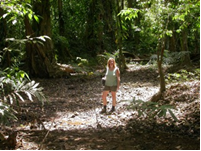 PIs: Jennifer Bowen, UMASS-Boston
PIs: Jennifer Bowen, UMASS-Boston
Ken Foreman, MBL Ecosystems Center
Funding: MIT Seagrant
Description: Permeable Reactive Barriers (PRBs) are currently being tested at the Waquoit Bay Reserve as a potential partial mitigation strategy for nutrient pollution. The barriers are designed to remove nitrogen by promoting microbially-mediated denitrification but there has been no examination of the microbial community that is responsible for the removal of the nitrogen and no attempt to understand how those microbial communities might respond to future environmental change. This project will use molecular biology to examine how the barriers, and the periodic inundation of seawater, alter the structure and function of the microbial community. This information will help determine the best placement of the barriers to maximize their effectiveness. Understanding how the microbial communities in the two barriers differ and under what environmental conditions the denitrifying bacteria thrive will help to guide future barrier construction, particular in the context of rising sea levels.
Multi-Cropping Shellfish and Macroalgae for Business and Bioextraction
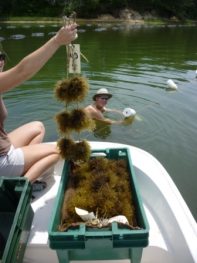 PI: Scott Lindell, Scientific Aquaculture Program, MBL. Funding: WHOI-Seagrant
PI: Scott Lindell, Scientific Aquaculture Program, MBL. Funding: WHOI-Seagrant
Description: Nutrient enrichment from septic systems is one of the most pressing coastal problems on Cape Cod. Towns are facing staggering costs for sewering and other solutions. This project aims to investigate whether a native seaweed, Gracilaria tikvahiae, can be co-farmed together with oysters to both soak up nutrients and produce a marketable crop.
Nitrogen Fluxes to Waquoit Bay via Groundwater Discharge: Identifying End Member Concentrations
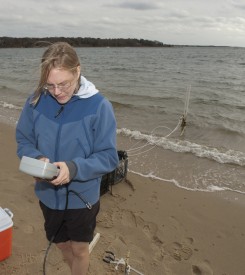 PI: Meagan Gonneea, MIT / WHOI Joint Program, PhD Candidate
PI: Meagan Gonneea, MIT / WHOI Joint Program, PhD Candidate
Advisor: Matthew Charette, Woods Hole Oceanographic Institution
Funding: NERRS Graduate Research Fellowship at Waquoit Bay NERR (current)
As groundwater flows to the coast, it meets and mixes with seawater. Mixing between these two water bodies creates a dynamic region-the coastal aquifer – where nutrients are chemically and biologically transformed. The fate of nutrients from development is a key issue in coastal areas like Cape Cod so understanding the processes in this area is of great importance. The mixing zone beneath Waquoit Bay was monitored for three years to observe how it changes with different seasons and responds to climate events such as the 2009-10 El Nino.
The Impact of Nitrogen-loading on Salt Marsh Greenhouse Gas Fluxes
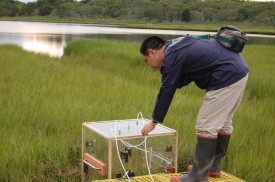 PIs: Serena Moseman-Valtierra, University of Rhode Island, Jianwu Tang, MBL Ecosystems Center, Kevin Kroeger, USGS-Woods Hole Science Center,
PIs: Serena Moseman-Valtierra, University of Rhode Island, Jianwu Tang, MBL Ecosystems Center, Kevin Kroeger, USGS-Woods Hole Science Center,
Funding: MIT Seagrant
The general goal for the project is to measure potential greenhouse gas (GHG) emissions and net CO2 uptake in coastal wetlands under a range of realistic nitrogen (N) loads and inundation (sea) levels. By meeting this goal, we aim to improve the information with which managers and policy makers can maintain and maximize ecosystem productivity, reduce harmful feedbacks of climate, and assess the potential for these ecosystems to enter C markets.
We will examine how GHG emissions from salt marshes vary along an existing gradient of anthropogenic N loading in Waquoit Bay, MA (WB-NERR). Further, we will test for relationships between N loads to the marshes and plant productivity. To investigate the influence of anticipated future increases in sea level, we will use existing gradients in marsh soil elevation (and therefore a gradient in soil water saturation and in frequency and duration of soil inundation) as a space-for-time substitution simulating future inundation of soils.
Carbon Management in Coastal Wetlands: Quantifying Carbon Storage and Greenhouse Gas Emissions by Tidal Wetlands to Support Development of a Greenhouse Gas Protocol and Economic Assessment
Project Title: Carbon Management in Coastal Wetlands: Quantifying Carbon Storage and Greenhouse Gas Emissions by Tidal Wetlands to Support Development of a Greenhouse Gas Protocol and Economic Assessment
Project Lead: Alison Leschen, Waquoit Bay Reserve Manager
Collaborative Lead: Tonna-Marie Rogers, Waquoit Bay Coastal Training Program Coordinator
Principal Investigator(s): Jianwu Tang, MBL Ecosystems Center, Kevin Kroeger, USGS-Woods Hole Science Center, Neil K. Ganju, USGS-Woods Hole Science Center, Serena Moseman-Valtierra, University of RI, Omar Abdul-Aziz, Florida International Univ., Stephen Emmett-Mattox, Restore America’s Estuaries, Igino Emmer, Silvestrum, Stephen Crooks, Consultant to RAE, Pat Megonigal, Smithsonian ERC, Thomas Walker, Manomet CCS, Chris Weidman, Waquoit Bay Reserve Research Coordinator,
Funding: NERRS Science Collaborative
Summary: Increasing atmospheric concentrations of three major greenhouse gases (GHG) are the main drivers of climate change. Efforts to ameliorate rising levels of GHG include the protection and restoration of ecosystems that constitute major carbon (C) sinks and minor sources of CH4 and N2O emissions. Tidal marshes are prime candidates for such efforts as their sediments display high C sequestration. Loss of wetlands through human impacts such as land conversion, sediment supply disruption, nutrient loading, and with sea level rise, reduces future sequestration capacity and places at risk stores of C that built up over past centuries. Improved management of coastal C and nitrogen (N), based upon sound science, is a critical first step towards mitigation of climate change and management of coastal ecosystems. Management must address N loading that has the dual impact of 1) contributing to climate change through production of N2O, and 2) reducing production of root and soil matter by plants which can decrease the C sequestration capacity and resilience of marshes to sea level rise. Recognition of the importance of coastal marine systems in terms of C storage has led to national and international efforts to place monetary value on preserving or restoring the “blue carbon” in those systems, analogous to the value placed on forests. The barrier to incorporation of tidal wetlands into C markets is the absence of agreed upon GHG offset protocols that set guidelines for monitoring and verification requirements for wetlands projects, and a lack of data and knowledge regarding C and GHG fluxes in wetlands to support model development.
The project goals are to provide scientific information that can inform both C and N management as well as wetlands protection and restoration strategies for supporting development of policy frameworks and market-based mechanisms to reduce GHG.
Project website: https://waquoitbayreserve.org/research-monitoring/salt-marsh-carbon-project/
Collaborative Research


